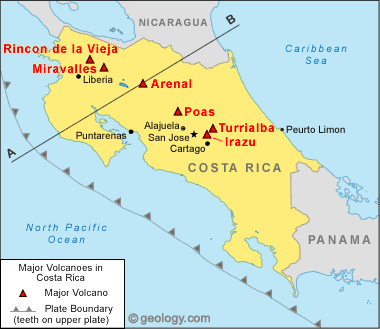Costa Rica will experience many different natural hazards in a year, but the most frequent and destructive natural hazard I believe is earthquakes. Costa Rica will experience hundreds of earthquakes a year, although not are high enough magnitude to be felt by the citizens of Costa Rica, they are happening daily. Costa Rica has a serious earthquake problem, so it would be beneficial to focus their resources on this situation, to prevent a serious disaster from happening. The reason why Costa Rica experiences all of these earthquakes each year, is due to the close proximity to the Cocos Plate. The Cocos Plate is located in the North Pacific Ocean, near the Southwest border of Costa Rica. The Cocos Plate is creating a convergent boundary with the Caribbean Plate. These are ocean-continental plates, and the Cocos plate is subducting under the Caribbean plate. The effect of this type of plate boundary is earthquakes, volcanoes, tsunamis, and flooding. This was also the cause for the 200 earthquakes of a 3.8 magnitude or higher, that Costa Rica experienced in 2018. An earthquake warning system would be on of the first step I would take to help the people of Costa Rica.
Having a warning system in place, would hopefully give people a minute or two to find a safe place to be, when the shaking begins. Another important step to take, would be to locate crucial facilities, like a police and fire station, as well as a hospital in a location that will not be least affected. Another crucial measure to take would be the structural support of the building. It is important that the buildings are up to code and have a higher chance of withstanding the damages of a high magnitude earthquakes. Costa Rica experiences earthquakes across the country due to its location, but the area that receives the most earthquakes is the surrounding area near the capital of San José. These cities are located on the South-West region of the country. This includes the cities that are located along the coast to the North Pacific Ocean, and include cities such as Puerto Quepos. To help limit the damage and the death toll of these natural hazards, I would start my making improvements to this region of the country.
To start, I would create a simple warning system that would alert to citizens in the area of a potential earthquake. This may give them a few minutes to find a safe place to be at when the earthquake hits, this would help to prevent serious injury or death due to being unprepared or in an unsafe location. Another important step to take, would be to locate crucial facilities, like a police and fire station, as well as a hospital in a location that will not be least affected. Another crucial measure to take would be the structural support of the building. It is important that the buildings are up to code and have a higher chance of withstanding the damages of a high magnitude earthquakes. If these improvements seem to be successful in this area, I would begin to spread them throughout the country. The North-East coast along the Caribbean Sea, is the least prone to experiencing harsh earthquakes. This is the area would be my first choice to build a house. It is one of the furthest areas from the tectonic plate within the country, and you would still be able to enjoy a beautiful coastline that Costa Rica has to offer.
References:







